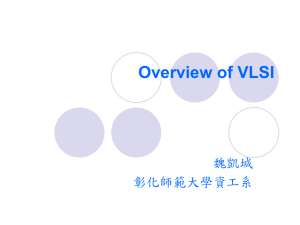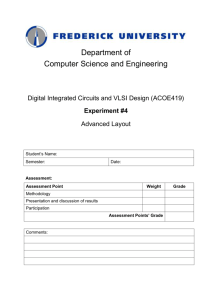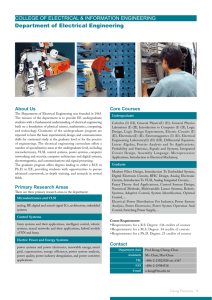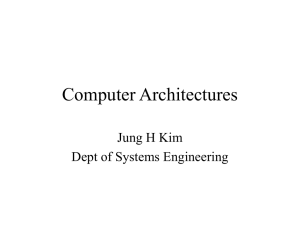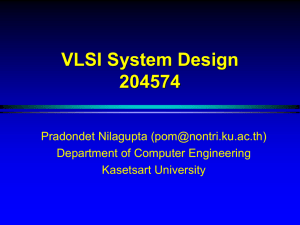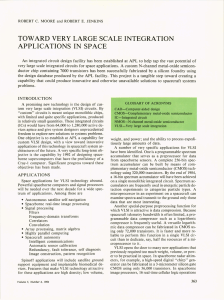EE5900: Layout Optimizations of Robust VLSI Circuits
advertisement
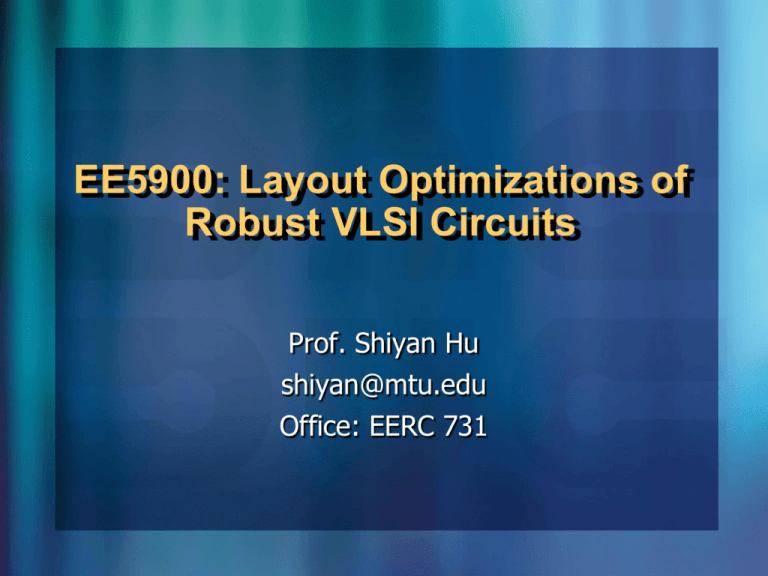
EE5900: Layout Optimizations of Robust VLSI Circuits Prof. Shiyan Hu shiyan@mtu.edu Office: EERC 731 Course Logistics Lecture Hours: Tuesday and Thursday 9:35am-10:50am Location: EERC 226 Instructor: Shiyan Hu – – – – Email: shiyan@mtu.edu Office: EERC 731 Phone: 906-287-2941 Office Hour: Tuesday and Thursday 11:00am-12:00pm. Class web page – http://www.ece.mtu.edu/faculty/shiyan/EE5900spring08 Prerequisites – Basic understanding of algorithms – Basic understanding of circuits 2 Notes Lecture – No textbook is required – Lecture notes will be posted on class web site Grading policy – Homework: 30% – Midterm Exam: 30% – Project: 40% 3 Chip 4 Microprocessor IBM S/390 Microprocessor 0.13um CMOS technology 47 million transistors 1 GHz 5 Cross-Section of A Chip 6 ITRS 7 Basic Components In VLSI Circuits Devices – Transistors – Logic gates and cells – Function blocks Interconnects – Local interconnects – Global interconnects – Clock interconnects – Power/ground nets 8 CMOS transistors 3 terminals in CMOS transistors: G: Gate D: Drain S: Source nMOS transistor/switch X=1 switch closes (ON) X=0 switch opens (OFF) pMOS transistor/switch X=1 switch opens (OFF) X=0 switch closes (ON) CMOS Inverter +Vdd X F = X’ X F = X’ Logic symbol GRD Transistor-level schematic Operation: X=1 nMOS switch conducts (pMOS is open) and draws from GRD F=0 X=0 pMOS switch conducts (nMOST is open) and draws from +Vdd F=1 Chip Design Manual System Specification Chip Automation Large number of devices Optimization requirements for high performance Time-to-market competition Power (and other) constraints 11 Time-To-Market 12 Design Automation Use automation tools (software/algorithm) to design large-scale circuits – Circuit – Optimization Industry – IBM, Intel, AMD, Cadence, Synopsys, TI, Magma, Mentor Graphics, Freescale … – More than half of companies in Silicon Valley are hardware-related New challenges in nanoscale circuits 13 Economic Impact Semiconductor industry has been one of the fastest growing sectors of worldwide economy. 14 VLSI Design Cycle System Specification e.g., Verilog Functional Design X=(AB*CD)+(A+D)+(A(B+C)) Y=(A(B+C))+AC+D+A(BC+D)) Logic Design and Synthesis 15 VLSI Design Cycle (cont.) Physical (Layout) Design Fabrication Packaging 16 Physical Design Physical design flow link Given a circuit after logic synthesis, to convert it into a layout (i.e., determine the physical location of each gate and the interconnects between gates). PD Better delay, better wirelength… 17 Nanometer Challenges Interconnect-limited designs – Interconnect performance limitation – Interconnect modeling complexity – Interconnect reliability (signal integrity) Power barrier (esp. leakage) Variation effects High degree of on-chip integration – Complexity and productivity – System on a chip 18 Moore’s Law The minimum transistor feature size decreases by 0.7X every three years (Electronics Magazine, Vol. 38, April 1965) Consequences of smaller transistors: – Faster transistor switching – More transistors per chip True in the past 40 years! Not true now – Interconnects – Variations Need more powerful CAD tools 19 Interconnects Dominate Delay (psec) 300 250 Interconnect delay 200 150 100 Transistor/Gate delay 50 0 0.8 0.5 0.35 0.25 Technology generation (m) Source: Gordon Moore, Chairman Emeritus, Intel Corp. 20 New Paradigm for VLSI Design Interconnection Transistors/Cells Transistors/Cells Interconnection Conventional Approach New Approach Interconnect-Driven Design 21 Power Crisis Exponential increase in sub-threshold leakage presents one of the most challenging issues in sub-90nm technologies. 1000 ity r Dens e w o P Active 100 Power (W/cm2) 10 C) 25 y( t i s en 1 rD e ow P e siv 0.1 s Pa Gate-Leakage 0.01 0.001 (courtesy of IBM) 0.0001 1E-5 1 0.1 L p o ly (u m) 0.01 22 Power density Power Density (W/cm2) 10000 1000 100 Rocket Nozzle Nuclear Reactor 8086 Hot Plate 10 4004 P6 8008 8085 Pentium® proc 386 286 486 8080 1 1970 1980 1990 2000 2010 Year Courtesy, Intel 23 Robust Design For Variations Variations – The difference between the designed value and the actual value Robust design – Mitigate or compensate for variations – Robustness for lithography-induced variations 24 Chip Design and Fabrication Lithography Process Designed Chip Layout Fabricated Chip 25 Photo-Lithography Process optical mask Part of layout oxidation photoresist removal (ashing) photoresist coating stepper exposure Typical operations in a single photolithographic cycle (from [Fullman]). photoresist development acid etch process step spin, rinse, dry 26 Lithography System Illumination Mask 193nm wavelength 45nm features Objective Lens Aperture Wafer 27 Mask v.s. Printing Layout 0.13µ 0.25µ What you design is NOT what you90-nm get! 0.18µ 65-nm 28 Motivation Chip design cannot be fabricated – Gap Lithography technology: 193nm wavelength VLSI technology: 45nm features – Lithography induced variations Impact on timing and power – Even for 180nm technology, variations up to 20x in leakage power and 30% in frequency were reported. Technology node 130nm 90nm 65nm 45nm Gate length (nm) Tolerable variation (nm) 90 5.3 53 3.75 35 2.5 28 2 Wavelength (nm) 248 193 193 193 29 29 Gap: Lithography Tech. v.s. VLSI Tech. 193nm 28nm, tolerable distortion: 2nm Increasing gap Printability problem (and thus variations) more severe! 30 Topics Traditional VLSI physical design flow – Interconnect optimizations and algorithms – Placement – Low power Variation-aware flow – Statistical optimizations – Design for manufacturability Optimization techniques Industrial flows 31 VLSI CAD Conferences DAC ICCAD ISPD ASP-DAC DATE – Design Automation Conference – International Conference on Computer-Aided Design – International Symposium on Physical Design – Asia and South Pacific DAC – Design Automation and Test in Europe 32 VLSI CAD Journals IEEE TCAD – IEEE Transactions on CAD of Integrated Circuits and Systems IEEE TVLSI – IEEE Transactions on VLSI Systems ACM TODAES – ACM Transactions on Design Automation of Electronic Systems IEEE TCAS – IEEE Transactions on Circuits and Systems Integration, the VLSI Journal 33
